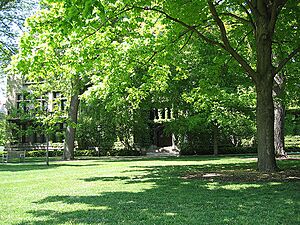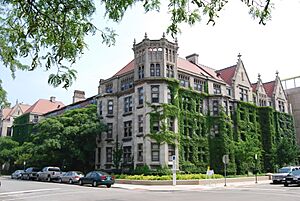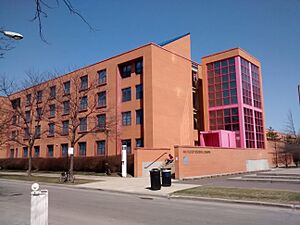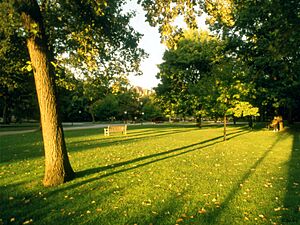History of the University of Chicago facts for kids
The University of Chicago was a brand new university started in 1891. It used the same name as an older school that closed in 1886. You can learn more about the old school at Old University of Chicago. Supporters worked hard to raise money, chose a new campus in Hyde Park, and opened the doors in 1890. Most of the first money came from a rich oil businessman named John D. Rockefeller and the American Baptist Education Society. The new university had a very energetic young president named William Rainey Harper. Classes officially began in 1892. From the start, the main goal was to create a top-notch university that covered all subjects, with a special focus on advanced research and learning.
Later, during the 1930s and 1940s, the university's fifth president, Robert Maynard Hutchins, made big changes to how students learned. One of these changes was creating the "Common Core" curriculum for undergraduate students.
Recently, the university has started building many new parts of its campus.
Contents
How the University of Chicago Started
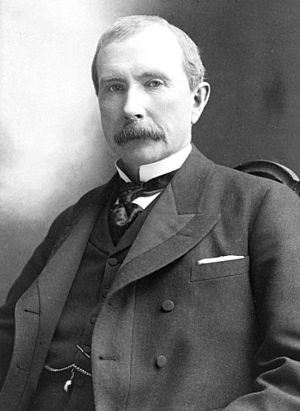
The University of Chicago's campus in Hyde Park began in 1890. This happened thanks to the efforts of the American Baptist Education Society and the wealthy oil businessman John D. Rockefeller. Rockefeller later said it was "the best investment I ever made." The university held its first classes on October 1, 1892. The first piece of land for the main campus was given by Marshall Field, who owned a famous department store. Other rich people in Chicago also gave money to match Rockefeller's offer. Martin A. Ryerson was the head of the university's board from 1892 to 1922. He gave over $2 million to the university, including money for the Ryerson Physical Laboratory.
The modern university took the place of an older school with the same name. To avoid confusion, the old school was legally renamed Old University of Chicago. Students who graduated from the Old Chicago University were later recognized as alumni of the new University of Chicago.
The founding of the university was part of a trend. Many new research universities were being started at that time, like Cornell University (1865) and Johns Hopkins University (1876). These schools wanted to be like the research-focused universities in Germany, such as the Humboldt University of Berlin. The University of Chicago was officially started in 1890, but it considers its founding date to be July 1, 1891. This was when the young William Rainey Harper became its first president. The first classes were held on October 1, 1892. There were 594 men and women students and 120 teachers, including eight who used to be college presidents.
As the country grew and industries developed, there was a greater need for excellent schools outside the East Coast. These new schools would focus on important national issues. Rockefeller eventually chose Chicago. He wanted to help talented people succeed, no matter their family background. His early focus on the physics department showed his practical and intellectual goals for the school.
William Rainey Harper was a respected scholar of religion and a Baptist minister. He believed that a great university should keep the study of faith as a main focus. He wanted to prepare students for teaching and research jobs, and ministers for serving the church and community. Because of this, he brought the Morgan Park Seminary to Hyde Park. This led to the Divinity School being founded in 1891. It was the first professional school at the new university. Even though it was started with Baptist support, the University of Chicago has never been officially linked to any specific religious group. The business school was founded in 1898, and the law school in 1902. Harper passed away in 1906. Other presidents followed until 1929. During this time, the Oriental Institute was created to support and understand archeological work in the Near East.
Like other research universities of its time, the University of Chicago focused on graduate research programs. This was similar to the German way of doing things. The College of the University of Chicago (the undergraduate part) stayed quite small compared to schools like Harvard and Yale until the mid-1900s. Undergraduate students often paid graduate students to teach them. This helped fund the graduate programs. Even today, there are twice as many graduate students as undergraduate students. The university has one of the lowest student-to-teacher ratios, which means students get a lot of attention. Almost all teachers also teach undergraduate classes.
The school's strong tradition of serious learning was mostly set by presidents Harper and Robert Maynard Hutchins. From the very beginning, Chicago welcomed women and minorities. This was a time when they often couldn't get into other leading universities. It was the first major university to accept women equally with men. It was also the first big, mostly white university to offer a Black professor a permanent teaching job in 1947.
Robert Hutchins' Time as President
Starting in the 1930s, the university tried a new and successful way of teaching its college students. To make the university a top place for undergraduate learning, leaders decided to use President Hutchins' idea of "secular perennialism." This led to the creation of the "Common Core." In this learning method, students read original writings instead of textbooks. They discuss these ideas in small groups using the Socratic method, which is like asking questions to help students think deeply. This Common Core is still a very important part of Chicago's undergraduate education today. Besides creating this new way of learning, the university also tried to get rid of "distractions." These included varsity sports, fraternities, and religious groups. This attracted independent thinkers like Carl Sagan and Kurt Vonnegut to the university. The university successfully stopped all varsity sports for 20 years and closed all but five fraternities. However, three of the closed fraternities were restarted in the 1980s.
Science at Chicago
The University of Chicago made many important contributions to science in the 1900s. In 1909, Professor Robert Andrews Millikan did the oil-drop experiment in the Ryerson Physical Laboratory on campus. This experiment helped Millikan figure out the charge of an electron. This discovery was very important for the theory of quantum mechanics in the 1940s. The American Physical Society now calls Ryerson Laboratory a historic physics site.
As part of the Manhattan Project (a secret wartime project), University of Chicago scientists, led by Glenn T. Seaborg, began studying a new radioactive element called plutonium. At the George Herbert Jones Laboratory, a tiny amount of this new element was separated and measured for the first time in September 1942. This helped scientists figure out the element's atomic weight. Room 405 of the building was named a National Historic Landmark in May 1967.
On December 2, 1942, scientists achieved the world's first self-sustained nuclear reaction. This happened at a university athletic field called Stagg Field, led by professor Enrico Fermi. A sculpture by Henry Moore now marks the spot where this historic event took place. This spot is also a National Historic Landmark. The original Stagg Field has since been taken down to make room for the Regenstein Library.
Other important scientific discoveries made at the University of Chicago include:
- The method of radiocarbon dating, developed in 1949 by Willard Libby and his team. Libby won the Nobel Prize in Chemistry in 1960 for this discovery.
- The discovery of the atmosphere's jet stream.
- The discovery of REM sleep (a stage of sleep).
- The discovery of synchronized menstrual cycles.
- The famous Miller–Urey experiment, which is considered a classic experiment about how life might have begun on Earth.
- The prediction of white dwarfs and black holes by Subrahmanyan Chandrasekhar, who won the Nobel Prize in Physics in 1983.
Arts at Chicago
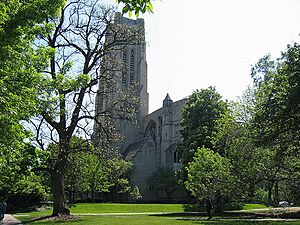
Even though the University of Chicago is well-known for its science and academics, its students and teachers have also made big contributions to the arts. In 1955, the University of Chicago became the birthplace of improvisational comedy. This happened with the creation of a student comedy group called the Compass Players. In 1959, alumnus Paul Sills, who many call the father of improv theater, started The Second City with Bernard Sahlins, also a university graduate. Since it began, The Second City Theater has inspired other comedy groups like Saturday Night Live. It has also helped many famous artists get their start, such as Alan Arkin, Mike Nichols, Harold Ramis, Bill Murray, Mike Myers, Stephen Colbert, Tina Fey, Jack McBrayer, and Steve Carell.
In 1964, Professor Ralph Shapey founded the University of Chicago Contemporary Chamber Players. This is one of the oldest and most successful professional groups in the country that plays new music. The Contemporary Chamber Players, also known as "contempo," has performed over eighty world premieres of music by both famous and new composers.
While teaching at the Committee on Social Thought, Professor Saul Bellow wrote several popular novels. These included Herzog in 1964 and Humboldt's Gift in 1975. For Humboldt's Gift, he won the 1976 Pulitzer Prize for Fiction and the Nobel Prize in Literature.
The University of Chicago also founded the Renaissance Society in 1915. This group focuses on showing contemporary (modern) art. The Society's 1934 show of Alexander Calder's "mobiles" and its 1936 survey of paintings and drawings by Fernand Léger were the first solo shows for these artists in the United States.
The Smart Museum was created in 1974, connected to the university's Art History department. It was supported by David A. Smart and his brother Alfred Smart. In 1983, the museum became a separate part of the university. It aimed to serve the whole community, including educational programs in local public schools. In 2000, it finished a $2 million renovation.
From the 1950s to the 1980s
In the early 1950s, fewer students applied to the university. This was partly because of rising crime and poverty in the Hyde Park neighborhood. To help, the university became a big supporter of a project to rebuild Hyde Park. This project changed the neighborhood's buildings and streets a lot. You can find more details about this effort in Hyde Park.
The university also saw student protests in the 1960s. It started in 1962 when students sat in President George Beadle's office. They were protesting the university's rules for off-campus housing. In 1969, over 400 students were upset about a popular professor being let go. They occupied the Administration Building for two weeks. After the sit-in ended, 42 students were expelled and 81 were suspended. This was one of the strongest responses to student protests at any American university during that time.
In 1978, Hanna Holborn Gray, who was then a top leader at Yale University, became President of the University of Chicago. She was the first woman to serve as the full president of a major research university.
From the 1990s to Today
In 1990, the Consortium on Chicago School Research (CCSR) was created. This happened after a law was passed that changed how Chicago's public schools were managed. Researchers from the University of Chicago joined with others to form CCSR. Their goal was to study these big changes and their long-term effects. Since then, CCSR has researched many of Chicago's school reform efforts. Some of these ideas have been used by other cities too. So, CCSR studies have also helped shape bigger national movements in public education.
In 1999, the president at the time, Hugo Sonnenschein, announced plans to make the university's famous core curriculum less strict. This meant reducing the number of required courses from 21 to 15. When major news outlets like The New York Times and The Economist reported this, the university became the center of a national debate about education. The changes were eventually put into place, but the disagreement led to President Sonnenschein stepping down in 2000.
In 2007, the University of Chicago received a $35 million gift from David and Reva Logan. This money was for building the Reva and David Logan Center for the Arts. President Robert Zimmer said the new arts center "will be a place for artistic expression and learning for our teachers and students." The building was constructed next to Midway Studios, which was the home and studio of sculptor Lorado Taft. The university chose the firm of Tod Williams Billie Tsien Architects to design the center.
Later in 2007, the University of Chicago received a huge gift of $100 million from a secret donor known only as "Homer." This donation will be the main part of a $400 million plan to help undergraduate students with financial aid. Starting in the fall of 2008, students could get special financial aid packages called Odyssey Scholarships. These scholarships aim to completely remove student loans for students whose families earn less than $75,000 a year. They also aim to cut student loans in half for students whose families earn between $75,000 and $90,000. The College expected almost a quarter of all undergraduate students to benefit from this program.
In 2008, the University of Chicago announced plans to create the Milton Friedman Institute. Friedman was a Nobel Prize winner in economics. He earned his master's degree in economics from the university in 1933 and taught there for over thirty years. The institute will cost around $200 million and will use the buildings of the Chicago Theological Seminary. Some teachers and students signed a petition against these plans. In the same year, investor David G. Booth gave $300 million to the university's Graduate School of Business. This was the largest gift in the university's history and the largest gift ever given to any business school.
Also in 2008, the University of Chicago and its surrounding neighborhood of Hyde Park gained international attention. This was because former Law School lecturer Barack Obama was elected President of the United States.
See also
- List of University of Chicago people
- Chicago school of economics
- Becker Friedman Institute for Research in Economics, since 2011
- Milton Friedman Institute for Research in Economics, 2008-2011
- Chicago school (sociology)
- Committee on Social Thought, interdisciplinary intellectual history, since 1941
- Crown Family School of Social Work, Policy, and Practice
- The Institute for the Study of Ancient Cultures, West Asia & North Africa (ISAC); before 2023 it was "the Oriental Institute," established in 1919.
- Pritzker School of Medicine
- University of Chicago Medical Center
- Regenstein Library, the main library since 1970.
- University of Chicago Graduate Library School, 1928-1989, now closed
- Smart Museum of Art
- Renaissance Society, art museum on campus; since 1915, an independent affiliate
- University of Chicago Booth School of Business
- University of Chicago Divinity School
- University of Chicago Hong Kong, since 2018
- University of Chicago Laboratory Schools, for pre-K to grade 12
- University of Chicago Law School
- Harris School of Public Policy
- University of Chicago Press
- List of University of Chicago Press journals


